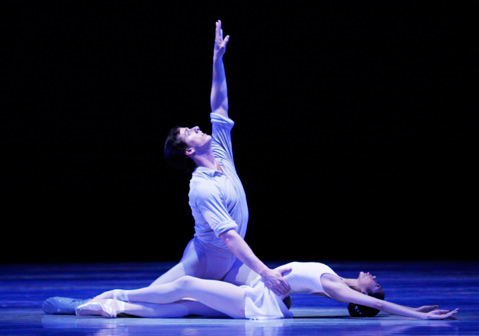The Joffrey Ballet Comes to the Granada
Santa Barbara Debut Includes Balanchine, Lubovitch

Chicago’s Joffrey Ballet has always prided itself on doing things a little differently. Younger than American Ballet Theatre (ABT) and the New York City Ballet, the Joffrey started out in 1956 as a six-member company that toured the country performing original works by cofounder Gerald Arpino rather than sticking to the safer territory of the classic story ballets. As early as the 1960s, founding director Robert Joffrey was commissioning modern dance choreographers to create works on the company—Twyla Tharp, Mark Morris, and Alvin Ailey among them.
Today, the Joffrey is a company of 42 dancers—less than half the size of their New York counterparts—under the direction of onetime principal dancer Ashley Wheater. This Monday, March 7, the company will make its Santa Barbara debut at the Granada. In advance of the performance, I spoke to Wheater about the Joffrey’s past, present, and future.
Let’s start by talking about the impressively varied program you’re bringing to Santa Barbara. This is the first tour of California we’ve done without our longtime director Gerald Arpino, and it’s a bit of a tribute to him. Arpino was the cofounder of the company with Robert Joffrey and held the helm after Joffrey’s death. So this program opens with Arpino’s neoclassical work, “Reflections.” It shows off Arpino’s aesthetic: a very high front arm for the women in arabesque; long, long movements; very articulate footwork; and then these beautiful, simple, very fulfilled pas de deux.
We’ll also be performing Balanchine’s “Tarantella,” which is a wonderful piece that shows off the technique of the dancers.
You’ve included a work by Lar Lubovitch on this program. How do your classically trained dancers take to his choreography? His work is very different, of course. If you haven’t done much contemporary dance, it can take some time to get into it. “… smile with my heart,” was created on ABT, so it’s made for dancers with a classical vocabulary. It’s for six dancers, and it uses a live piano onstage.
We close with “Age of Innocence” by Edwaard Liang. Ed has a fantastic way of working in the studio with the dancers. He was inspired for this piece by Jane Austen’s novels, and the way everything significant happens through a social dance of some kind. Between the Arpino on the one hand and the Liang on the other, I think we can bring a part of the old Joffrey and then also the new. The Joffrey has always been known for being eclectic and being able to tackle anything. I think this program demonstrates that.
As a director, how do you find that balance between the old and the new? I think that in any cultural institution, you have to honor the history. As a director, it’s wise to look at what has been the backbone of a company. Joffrey had immense respect for the Diaghilev period, and at the same time, he was the first person to go to Twyla Tharp and Mark Morris and ask them to do a piece on a classical ballet company. So there is always this juxtaposition between the love of traditional work and the desire to move ahead. I believe Joffrey designed the blueprint for what has become the ballet company in America today: doing new work, but also honoring the past in classical full-length ballets.
When times are tough economically, touring can become a rare thing for many companies. But I truly believe that the Joffrey has always been a touring company. We keep the company slightly smaller for that reason, and we enjoy going to different places and giving everything we’ve got. As a director, it’s always going to be about judging the balance. Our subscribers want full-length ballets; I also want to give space for young people to choreograph, and we want to tour, as well.
There’s a lot of talk about the arts and dance in particular being endangered in this country. How do you see the future of dance in America? For me, it’s very important that the dancers we are training today have the ability to understand the technique to really execute every aspect of the art form. When the language starts to get narrower and the emphasis is, “You’ve got lovely legs and feet,” then we’re running into trouble. What we want to keep alive is the choreographer’s intention: the musical layers of a Balanchine ballet, say, or the dramatic intent. If we start losing those layers, everything is a facsimile without any depth.
One thing I’ve always loved about dancing in America and living here is this beautiful, broad, expansive movement that Americans have always had. Americans love to explore the outer boundaries of movement, and I think that’s something we really want to keep alive. So we need to give dancers a really rich diet of work to explore. There is a wealth of work out there, but you need to help the dancer understand every level of it. Then you have something really worth looking at.
4•1•1
The Joffrey Ballet of Chicago will give its Santa Barbara debut at the Granada on Monday, March 7, at 8 p.m. For tickets, call 893-3535 or visit artsandlectures.sa.ucsb.edu.



